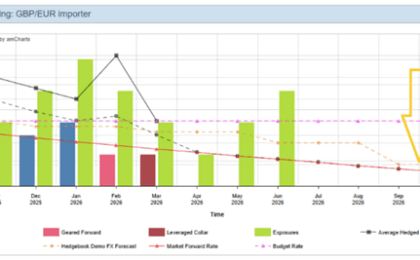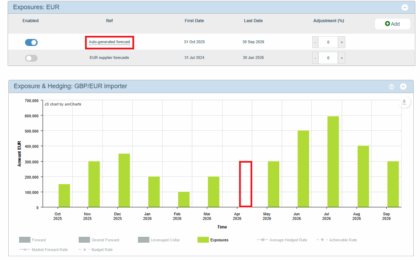As the end-of-year compliance burden grows for Australian and New Zealand organisations, we put together a practical financial instrument check list for those exposed to financial instruments such as FX forwards, FX options and interest rate swaps.
Financial year-end for many Australian and New Zealand public and private companies, as well as Councils, is a time of stress and added complexity . With an ever increasing compliance burden, we have put together a practical check list for those entities that have exposure to financial instruments such as FX forwards, FX options and interest rate swaps.
Those familiar with the international accounting standards understand the minefield of financial instrument compliance. We have tried to boil them down to five simple, practical and fundamental items for you to check off:
1. Fair value (IFRS 13 / AASB 13)
IFRS 13 clearly states that valuations need to be an independent “exit price” for the transaction. It is hard to argue that a valuation from one of the counterparties to the transaction (i.e. the bank), constitutes an independent valuation, however, there are still many companies that rely on their bank for this information.
Such reliance on the bank is understandable when the auditor accepts this approach, although we are seeing a much bigger push by the audit community to challenge companies on the lack of independence of a bank valuation given the bank is counterparty and valuer of the financial instrument. Historically there have been few economic alternatives to bank valuations, that is no longer a valid argument.
2. CVA/DVA (IFRS 13 / AASB 13)
Companies using financial instruments are required to adjust the risk free valuation by a credit component. IFRS 13 requires a Credit Value Adjustment (CVA) or Debit Value Adjustment (DVA) to all financial instruments.
Financial institutions have been credit adjusting their own positions for years, however, the requirement has filtered down so that all parties to financial instrument transactions must calculate and apply a credit adjustment.
There is a strong argument that it is overkill for companies using financial instruments to hedge their foreign exchange cashflows (payments/receipts) or debt using plain vanilla instruments to have to make CVA/DVA adjustments. There is little added-value to the company, there is a cost to calculate the adjustment and the number is often immaterial (still have to calculate the number to determine its immateriality, however).
It is different if you are trading financial instruments or are using credit hungry instruments such as cross-currency interest rate swaps but auditors, as prescribed by the accounting standards, are (or should be) forcing all financial instruments to be adjusted by CVA/DVA.
There are a multitude of approaches to calculating CVA/DVA from the complex (potential future exposure method) to the simple (current exposure method). For those using plain vanilla instruments such as FX forwards or interest rate swaps then a simple methodology is appropriate.
It is worth noting that the movement in both FX rates and interest rates over the last 12 months means valuations have moved significantly over the last 12 months which results in higher, more material CVA/DVA adjustments.
3. Sensitivity analysis (IFRS 7)
As part of the notes to the accounts under IFRS 7 there is a requirement to include a sensitivity analysis for financial instruments. This is a “what if” scenario that requires the re-calculation of fair value if the underlying market data is flexed.
Often a +/-10% movement in the spot rate is used for FX instruments and a +/-100bp parallel shift in the yield curve for interest rate instruments. In theory there should be some sense check applied to the probability of the movement occurring i.e. if interest rates are close to zero then there is a low probability of a -100 basis point adjustment in the curve. We see little evidence of this in practice.
4. Hedge effectiveness testing (IAS 39 / IFRS 9 / AASB 9)
One of the biggest headaches at year-end is for those hedge accounting. Hedge accounting was introduced for practical reasons – remove noisy P&L volatility from unrealised gains/losses on financial instruments and put these adjustments on the balance sheet instead.
In the early days of hedge accounting the approach was complicated and expensive. As auditors and accountants understanding of hedge accounting has developed over time, the process of hedge accounting has become much less complex. The most important aspect is the documentation.
The effectiveness testing aspect of hedge accounting is fairly straightforward, particularly when utilising a treasury management system. The replacement of IAS 39 by IFRS 9 (effective 1 Jan 2018) made hedge accounting a little easier with the removal of the 80-125% bright line.
5. Time versus intrinsic (IAS 39)
Ever since IFRS 9 took effect in 2018, companies hedge accounting for FX options (whether outright purchased options or in a collar relationship) must split the value of an option into its time and intrinsic components.
The intrinsic value of an FX option is the difference between the prevailing market forward rate for the expiry of the FX option versus the strike price. The time value of an FX option is the difference between the overall FX option valuation and the intrinsic value.
By definition, time value is a function of the time left to the expiry of the FX option. The longer the time to expiry, the higher the time value as there is a greater probability of the FX option being exercised.
The intrinsic value goes to the balance sheet whilst the time value goes to P&L. Splitting time and intrinsic value is not too easy to do on the back of an envelope/spreadsheet, rather it is something that lends itself to be derived from a system.
Summary – financial instrument checklist
Many companies try to complete the necessary compliance through using spreadsheets and bank valuations which is not only poor practice (valuations should be independent) but also error prone and time consuming. There are low cost systems available – such as Hedgebook – that can streamline, simplify and improve the ever increasing burden of year-end reporting requirements.
This article should not be taken as accounting advice but rather a practical guide and year end financial instrument check list.





